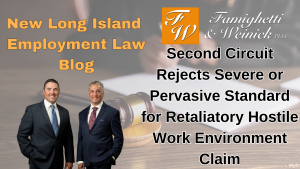Title VII of the Civil Rights Act of 1964 prohibits various forms of workplace discrimination, including discrimination based on sex, race, religion, and national origin. Title VII also includes an anti-retaliation provision which protects employees who complain about or oppose conduct which is unlawful under Title VII. This is referred to as engaging in protected activity.
To prove a discrimination or retaliation claim in court, an employee must prove, among other things, that he or she suffered an adverse action. At Famighetti & Weinick PLLC, we typically describe this requirement as having to show that the employer did something bad enough in the eyes of the law. One thing an employer may do to an employee in retaliation for an employee engaging in protected activity is to subject to the employee to a retaliatory hostile work environment.
In August 2023, the United States Court of Appeals for the Second Circuit issued an opinion clarifying the legal standard used to analyze retaliatory hostile work environment claims. Today’s Long Island employment law blog takes a look at the case Carr v. New York City Transit Authority.
Title VII prohibits workplace discrimination based on an employee’s protected characteristics such as race, religion, sex, gender, or national origin. It also prohibits employers from retaliating against employees who complain about or oppose activity which Title VII prohibits. Both claims require that an employee prove that an adverse action occurred.
To put it another way, courts often write that Title VII was not enacted to broadly implement a workplace civility code. Thus, not every slight or perceived wrong which an employee suffers may give rise to a workplace discrimination or retaliation claim — even if motivated by an animus towards the employee’s protected characteristic. Rather, courts generally require that the employee to have suffered a material change to the terms and conditions of employment. Clear cut examples include a termination or a demotion with loss of pay.
Under the discrimination law, employees may also claim that they suffered a hostile work environment. In interpreting Title VII, to prove a hostile work environment claim, courts require that employees show they faced unwelcome abusive conduct based on a protected characteristics. Notably, and as is relevant for this blog, employees must also show that the conduct was either severe of pervasive.
Under the retaliation law, employees can also show they suffered an adverse action by showing they faced a retaliatory hostile work environment. The concept of a retaliatory hostile work environment has been widely accepted by many courts. In New York, however, the legal analysis of such claims has not been settled. The Carr case changed that.
In Carr, the Second Circuit has to determine the appropriate standard to evaluate retaliatory hostile work environment claims. The trial court used a standard which mirrored the analysis for a discriminatory hostile work environment — the severe or pervasive standard.
On appeal, the Second Circuit detailed the history of the law concerning the definition of adverse action in the context of discrimination verse retaliation. The leading case concerning the distinction is Burlington Northern & Santa Fe Railway Company v. White, commonly referred to as just Burlington Northern. In Burlington Northern, the Supreme Court ruled that the harm an employee must show for retaliation, i.e. the adverse action, is a lower threshold showing than for a discrimination claim.
The key distinction drawn by Burlington Northern is that for retaliation, an employee need only show that the adverse action either in singularity or in the aggregate was materially adverse. The Supreme Court emphasized that this standard is broader than what an employee must show for purposes of a discrimination adverse action. Specifically, the Supreme Court ruled that a retaliatory adverse action is one which dissuade a reasonable employee from making or supporting a charge of discrimination.
Applying these principles to Carr, the Second Circuit ruled that since the harm for a retaliation claim is not the same for a discrimination claim, then the severe of pervasive analysis is not correct. Rather, to determine whether an employee has met the standard for a retaliatory hostile work environment claim, the employee must prove that the retaliatory actions taken were singularly or in the aggregate, materially adverse, meaning sufficient to dissuade a reasonable employee from making or supporting a charge of discrimination.
As employers become more sophisticated and knowledgeable about employment laws, they are more prone to conceal their retaliatory conduct in the form of ongoing lesser harms, instead of an obvious retaliatory action such as a termination. The Carr case is an employee-friendly case which makes it easier for employees to prove they suffered a retaliatory hostile work environment based on a series of lesser harms.
If you have questions about workplace retaliation, a retaliatory hostile work environment, or the Carr decision, contact a Long Island retaliation lawyer at Famighetti & Weinick PLLC. Our phone number is (631) 352-0050.

Second Circuit Rejects Severe or Pervasive Standard for Retaliatory Hostile Work Environment Claim
 Long Island Employment Law Blog
Long Island Employment Law Blog

